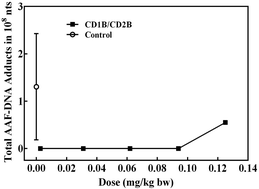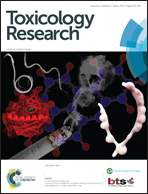A no observed adverse effect level for DNA adduct formation in rat liver with prolonged dosing of the hepatocarcinogen 2-acetylaminofluorene
Abstract
We have previously reported that the DNA-reactive hepatocarcinogen 2-acetylaminofluorene (AAF) produced in rat liver several key effects that were less than linear over a range of repeat doses, and that at low cumulative doses, no-adverse-effect-levels (NOAEL) were observed for several effects including hepatocellular cytotoxicity, enhanced cell proliferation, induction of preneoplastic foci and promotable liver neoplasms, although DNA adducts were still formed at dosages below the lowest NOAEL of 28 mg kg−1 cumulative dose for these other effects. This report details two further dose-effect studies at lower repeat doses than those previously used as well as identification of the specific types of DNA adducts formed. AAF was administered orally to male F344 rats by gavage at repeat dosages which in one experiment (A) ranged from 0.01 to 2.24 mg kg−1 bw per day, 7 days per week for 12 weeks followed by recovery for 4 weeks, and in a second (B) at lower dosages of 0.0026 or 0.026 mg kg−1 bw per day 3 days per week for 16 weeks. Initially the nonacetylated guanine adduct, N-(deoxyguanosine-8-yl)-aminofluorene, predominated. With continued dosing, the pattern of adducts changed such that by 4 weeks more acetylated, N-(deoxyguanosine-N2-yl)-AAF and N-(deoxyguanosine-8-yl)-AAF, adducts were present. In experiment A, total adducts reached a maximum by 12 weeks with levels of 6.0 adducts per 108 nucleotides at the lowest dosage. In experiment B, the total DNA adducts at the lowest dosage was below the limit of detection at 12 weeks, and at 0.6 in 108 nucleotides at 16 weeks, levels within the background range of 1.0–3.1 per 108 nucleotides. Thus, the cumulative dose of 0.125 mg kg−1 bw over 16 weeks was a NOAEL for adducts and hence would be predicted to be a threshold for hepatocarcinogenicity.


 Please wait while we load your content...
Please wait while we load your content...